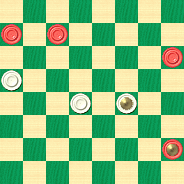The Checker Maven
Jump to navigationTangled Skeins

The title for today's Checker School lesson, taken from Ben Boland's Famous Positions in the Game of Checkers, has less to do with the position itself than with the commentary that follows it in the original book. We'll look at the position first, and we'll discuss the commentary in the solutions section of our column.
BLACK

WHITE
White to Play and Draw
W:W13,18,K19:B5,6,12,K28.
White seeks to obtain a man-down draw; as usual, there are compensatory factors that must be relied upon to make up for the material deficit. Here, White's better mobility seems to be his only edge, but whether or not that's enough depends on the skill and technique of the White checkerist.
Can you untangle this one, or will it remain a knotty problem? No worries, you can click on Read More to unwind the solution, explanatory notes, and a sample game, as well as viewing the "Tangled Skeins" commentary.![]()
Solution
Lettered notes are by Mr. Boland; numbered notes are by the Editor.
18-14, 28-32, 19-24---5, 12-16---1, 24-20, 16-19, 20-16, 19-24---2, 16-11, 32-27, 11-15, 27-23, 14-9---3, 5-14, 15-18---4. Drawn.
1---Obviously Black will not simply play 32-28, leading to an eventual repetitive draw, but being a piece up must try for the win---Ed.
2---This is better than 19-23 as White now cannot continue to chase with 16-20 because of 32-27 to a Black win---Ed.
3---14-10 loses to 23-18---Ed.
4---The "Double Breeches" --- and a spectacular save for White.
5---Trying to press the Black man on 6 looks like the simple solution, but it doesn't work: 19-15 12-16 14-10 32-28 10x1 16-19 15x24 28x19 1-6 19-15 6-1 15-10 Black Wins. Many a player would not (or could not) look ahead far enough and would lose this one!
Game: 11-15, 21-17, 9-13, 25-21, 8-11, 17-14, 10-17, 21-14, 6-10, 22-17, 13-22, 26-17, 15-18, 24-20, 1-6, 29-25, 18-22, 25-18, 10-15, 28-24, 15-22, 24-19, 6-10, 27-24, 11-15, 23-18, 22-25, 18-11, 7-23, 30-21, 3-7, 32-28, 2-6, 17-13, 10-17, 21-14, 7-11, 24-19, 4-8, 28-24---A, 23-27---B,5, 19-15, 11-18, 24-19, 27-32, 31-27, 32-16, 20-4, 18-23, 4-8, 23-27, 8-11, 27-32, 11-15, 32-28---C,6. Forms above position. J. Evans vs. T. G. Richards, Game No. 3666, The Weekly Times, Melbourne, Australia, July 11, 1936.
A---14-10, 6-24, 28-19. Draws. J. Evans.
B---Left here as a Black Win in Game No. 3475, the Weekly Times. Then in Game No. 3645, G. O. Scace, suggested White could draw.
C---In the above game J. Evans played; 12-16, 14-10, 32-28, 10-1, 16-19. Black Wins; 32-28 was shown to draw and was given as Problem No. 3838, by J. Hatton, July 4, 1936.
5---Computer analysis actually does show a highly probable Black win here with 23-27---Ed.
6---This last move blows away the win. Correct is an immediate 12-16 and Black goes on to a very instructive win, for instance 12-16 15-18 16-19 18-22 32-27 22-18 27-31 18-15 31-26 15x24 26-23 24-28 23-18 Black Wins. While the computer often plays moves that humans never would, here KingsRow uncovers an elegant win which even highly skilled analysts overlooked---Ed.
The above position by A. J. Heffner may be found as No. 295 in Horsfall's Problem Book. It may also be found as No. 49 by R. Robertson, Dunne's Guide, No. 837 in Dunne's Draughts Column, March 22, 1890, this in turn was taken from the Glasgow Herald. And also by W. Beattie as No. 414 in the Liverpool Weekly Mercury, 1896.
This theme "The Double Breeches," may be found in "Boland's Familiar Themes."
And now, here is the commentary printed below this problem in the original book.
"The Tangled Skeins!"---Mr. Shearer gave the following advice to rising problemists:—"Have a preference for problems with natural settings, such as might occur in actual play, and therefore, critical end-games and brilliant coups' are always welcome. The big involved stroke, however, will always have a charm for the novice, and also for fair players who have not yet joined a draughts club. The stroke, in order to merit its place, should be sufficiently well concealed to baulk a good player from solving it off the diagram. Open positions, where a number of clever moves forces a stroke or coup, are attractive to all grades of players. The hard endings, where the result has to be achieved by long sustained tactics, repels the weaker player, and appeals to the highest class of solver. The educative value to all grades of checkerists of the last category of problems is so great that they are indispensable. In composing such problems as the big sweep or forced coup the advice given by the best authorities is to fix on the idea you wish to illustrate, and then conceal it as carefully as possible by building an involved position or by retracting the moves and adding a piece or two if a coup is desired."
---The Draughts World
Given the fact that stroke problems are a "love 'em or hate 'em" affair for most checker players, we're not quite sure what Mr. Shearer was trying to tell us, back in the day. We gather that Mr. Shearer was no fan of stroke problems, viewing them as something to entertain novices, who didn't have what it takes to appreciate difficult endgame problems which have far greater intrinsic merit. Is there a bit of elitism here? We're not sure; Mr. Shearer does explain how to make the stroke "attractive to all grades of players." In the end, we do detect a bit of an edge in Mr. Shearer's remarks, though far short of the "harrumphing" approach of pedantic checker writers such as Harvey Hopkins.
You can email the Webmaster with comments on this article.
